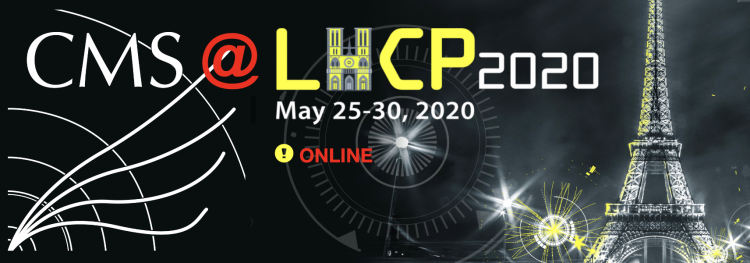
The eighth annual conference on Large Hadron Collider Physics (LHCP2020) is one of the important conferences for physics at the LHC. Originally planned to take place in Paris, LHCP is operating as a fully virtual conference this year. The CMS Collaboration has released over 22 new results for LHCP2020. The data collected by the CMS experiment in 2015 through 2018, during LHC Run 2, is proving to be an extremely fruitful source of physics results, with new analyses and techniques continuously being developed and allowing refinement of existing results on a more extensive dataset.
One of the highlights for LHCP2020 are searches for the rare, simultaneous production of multiple W and Z bosons. These events with three heavy gauge bosons have been observed at the LHC with a combined five-sigma observation of VVV production (where V can be either a W or Z boson) that included the evidence for WWW and WWZ production, individually. The study of vector-boson-scattering, where W and Z bosons are produced with two forward jets, has led to the CMS evidence in the ZZ channel. Another first observation reported at LHCP2020 is the production of a W boson and photon in this production mode. The study of vector-boson scattering is an essential step in the understanding of electroweak symmetry breaking, the physics mechanism that is connected to the Higgs boson. These rare and complementary production modes provide essential input on how the Standard Model and the mechanism of electroweak symmetry breaking behave at a high energy scale.
The interactions of many massive bosons also provide important constraints on the four-boson interaction strength, the so-called quartic gauge coupling, which has substantial sensitivity to virtual corrections by new particles. Many other new results on the physics of the W and Z boson have been presented, including the total and fiducial WW boson differential cross sections that provide an interpretation in terms of the Standard Model Effective Field Theory parameters, and precision measurements of the Z/gamma differential cross section in events where these particles are associated with jets.
In the flavour sector, the CMS Collaboration has announced the first observation of the decay of the B0s meson to the X(3872) and phi meson. The X(3872) particle is currently under intense study by many experiments. Its nature is still unclear, with hypotheses including a tetraquark or a molecular state of two D mesons explaining the resonance. This is the first time X(3872) is observed in the decay of a neutral Bs meson, a particle containing a bottom quark and strange quark, providing essential input to the nature of this mysterious resonance. A refined measurement of the double resonance interpreted as the Bc+(2S) and Bc∗+(2S) particles has also been released for LHCP2020, providing more information on the relative contributions of the two particles after their first observation in 2019 by the CMS Collaboration.
The physics of the top quark is, as always, a fruitful field for the ever-increasing precise study of the Standard Model and new analysis techniques. CMS physicists have expanded the knowledge of top quark pair differential cross sections to the boosted regime at particle and parton level, providing crucial information on the understanding of the kinematic behaviour of the heaviest known elementary particle. A new measurement of the top quark Yukawa coupling from top quark kinematic distributions in the dilepton final state has also been released.
The study of the Higgs particle is a dynamic topic, with new results by the CMS Collaboration on the production of Higgs bosons at large Lorentz boosts, including differential cross sections. Another new result sets limits on the extremely rare decay of the Higgs particle into a Z boson together with a rho or phi meson. Searches for additional Higgs bosons have also been presented, including first such bounds for a heavy Higgs boson decaying to two light pseudoscalar Higgs bosons. The Higgs has also been studied in its decay to low-mass dilepton pairs, providing an interpretation in dark photon and axion models.
A powerful search for long-lived particles decaying to jets has been shown first at LHCP2020. This analysis sets competitive limits in a large range of models predicting displaced hadronic signatures at the LHC. New searches for supersymmetric top quark partners and gluino cascade decays into boosted hadronic Z bosons and missing transverse momentum have also been released for LHCP2020. Also in the case where the new physics model is not known, CMS physicists ensure that no stone is left unturned with the Model Unspecific Search in CMS (MUSiC) that has shown limits for the first time on the data collected in 2016.
Other important results released for the LHCP2020 conference include new tunes for the Herwig event simulation program that is essential for most other LHC results and multiple new measurements of the Z boson in lead-lead and lead-proton collisions. A new result combines data from the CMS and TOTEM experiments and studies the strong interaction in LHC proton-proton collisions where the protons do not necessarily fracture into many particles, probing the hard colour-singlet exchange in dijet events with a large rapidity gap and with or without a leading proton.
Despite the challenging times that the COVID-19 constraints create for society, the extremely diverse and high-quality physics results presented at the LHCP2020 conference are evidence of the resilience of the CMS Collaboration under demanding circumstances. There are still many mysteries to be uncovered in the LHC data, and the new results show that the CMS Collaboration is set to produce precise and novel results with the large dataset expected for LHC Run 3 and the High Luminosity LHC.
Read more about these results:
- Log in to post comments

